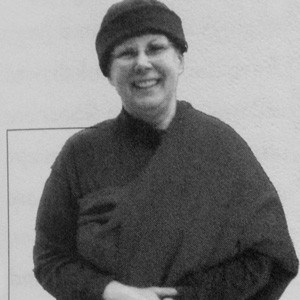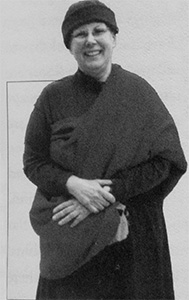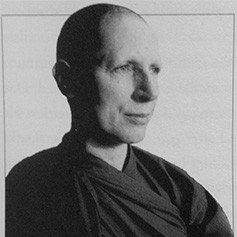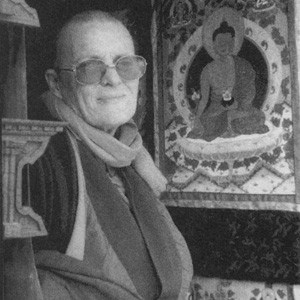Blossoming in Plum Village
Blossoming in Plum Village

From Blossoms of the Dharma: Living as a Buddhist Nun, published in 1999. This book, no longer in print, gathered together some of the presentations given at the 1996 Life as a Buddhist Nun conference in Bodhgaya, India.

Bhikshuni Tenzin Namdrol
Plum Village consists of several hamlets pervaded by the presence of Thich Nhat Hanh, or Thay as he is called by his disciples. The air in this part of France is crystal clear, and the rolling landscape dotted with old farms delights the eye. In summer, Plum Village is filled with visitors, and children enjoy the swings, seesaws, sandbox, and tree houses on the grounds. In winter the premises are quieter, and the monastics do retreat.
Lower Hamlet comprises seven buildings individually housing nuns, single women, couples and children. A small zendo, service areas, library, shed, bookstore, and one large zendo or meditation room also fill the cluster. To hone the notion of community, nuns and single women are assigned three to a room regardless of how many empty rooms exist. No furniture other than beds is in the bedrooms, and all belongings are kept in a large common room. In the common study, we each have our own bookshelves for study materials. The buildings lack sound insulation, and the floors are made of hollow planks, but we hear no feet treading and no chatter except on “lazy days,” the one day each week when no tasks except cooking are done.
New Hamlet consists of a manor house shared by Vietnamese and Western nuns, lay women, and the Vietnamese abbess. It has two beautiful, small zendos and a large one in the meadow. Upper Hamlet stands on a flat hill surrounded by grassy fields and woods containing meditation cabins. Here monks and lay men live. Each hamlet has a rectangular zendo where over three hundred people can easily sit.
In the nuns’ house at Lower Hamlet live Sister Abbess and eleven Vietnamese nuns: eleven are bhikshunis and one is a novice. The abbess, Sister Jina, a European well versed in both Western and Eastern traditions, is well loved and respected. The sangha lives as one precept body, forming individuals into a true community that makes decisions and shares responsibilities. This close communal living brings much freedom and joy to each member and makes refuge in the sangha a powerful part of our daily lives.
The nuns are the core of the community. Reminded to use skillful means to work out personal differences, they manifest joy and trust in one another, thus setting the tone for the rest of the community. All tasks and chores are rotated and accomplished by groups of five or six practitioners led by a nun. Each group cooks once a week, the only person exempt from this task being the abbess. Hers is the only set position; all others are changed periodically. If a sister is especially gifted in an area she may be assigned to a project in which that skill is needed. However, once the project is completed, she rejoins the pool of sisters and is assigned to another job. Mindfulness practice quickly appeases our speedy habits. Nuns are expected to handle a multitude of tasks demanding training in such varied fields as art, computers, rituals, singing, and public speaking. Nevertheless, no one appears burdened by any task, and no one is irreplaceable. Closed offices where specialists remain on working binges are absent in Plum Village. The nuns are humble, educated, well balanced, and cheerful.
Mindfulness in daily life
Our practice centers on continuous mindfulness in which we pay attention and bring joy to each activity. Work is done in silence, and when the mindfulness bell rings, we pause and breathe mindfully three times before returning to whatever we were doing. Walking anywhere—from the table to the sink, to and from our house—is done slowly and mindfully, bringing body and mind in harmony regardless of the chores we are carrying out. When the phone rings, which is constantly during the day and several times during meals, we stop what we are doing, are mindful of our breath, and answer the phone with a smile after the third ring. Every fifteen minutes clocks chime, and again we stop to focus on our breath, resuming whatever we were doing when the chimes stop. When we talk, we don’t walk; when we walk, we don’t talk. We do one thing at a time, always mindfully. Mindfulness opens our hearts to the here and now; we discover within ourselves infinite gratitude for life, as well as for the soil we tread and the oxygen we breathe. Mindfulness transforms our careless, self-centered ways into gentle, loving ones.
We are trained to be attentive to our interactions with each other. During the fine manners class, inspired by Stepping into Freedom, a book of monastic conduct, we learn to respect others and to actively demonstrate that respect. For example, before and after addressing any monastic, we gassho or bow to the person. We do this as well before sitting down for a meal or meditation. We learn and practice kitchen manners, dining room manners, bathroom manners, and zendo manners, making life pleasant and caring. These rituals lend sacredness to our lives.
Beauty and music are important at Plum Village. Many of Thay’s poems have been set to music, and monks and nuns often sing together. The Heart Sutra has been set to a simple melody, and by chanting it every morning, we carry the tune in our hearts throughout the day.
The day begins with a bell at 5:00 AM, and a half-hour later we meet for chanting and walking meditation. At 7:00 AM, we return to our rooms for individual practice until the bell is invited for our simple but scrumptious breakfast, prepared by that day’s cooking team. In the evening after the day’s cleaning team has finished its work, the bell is invited again for evening meditation and liturgy until almost 10:00 PM. We are never tired, and time flies.
Twice a week Thay gives teachings in one of the hamlets, which hosts the others. A youthful 72, Thay is a simple monk, as His Holiness the Dalai Lama also likes to call himself. Permanently in a deep state of mindfulness, he glides slowly into the zendo, followed by two monks or nuns, who are never the same. He sits on a cushion on a elevated platform before a low lectern when teaching, but he also walks about and writes on a large board, sometimes sitting sideways on the platform. His simplicity, in contrast to the sophisticated PA system, makes Thay appear accessible, although he seldom addresses anyone personally and does not allow time for questions. Every few weeks, however, he announces “Dharma a la carte” in which questions collected from his students form the basis for the day’s teachings. When teaching, he speaks first in Vietnamese, with simultaneous translations done by his students into English and French. Then he speaks in either French or English, with simultaneous translations into the other languages. Groups of German, Italians, Spaniards, and others improvise their own translations.
After the teachings, we form a circle outside to sing simple Dharma songs, followed by a forty-five minute walking meditation led by Thay. Lunch is formal: we sit according to a strict seating arrangement, eat in silence, and use our begging bowls. Meals can take a long time since we are often interrupted by various bells and rings, each prompting us to pause and breathe mindfully three times. In the afternoon, we meet for either a tea meditation or a Dharma discussion, and in the evening we gather again for meditation and chanting until 10:00 PM.
Community
The Plum Village sangha comprises approximately one hundred monks and nuns, with about sixty living in Plum Village and forty in Maple Forest Monastery in Vermont. Before receiving the first vows, candidates live in Plum Village to experience the lifestyle for several months. In this way, they can determine if it is appropriate for them, and the community can also see if a candidate is sufficiently prepared for monastic life. The sense of community is strong, and only ten percent of the monastics have disrobed. Thay attributes this, as well as the spread of his teachings, to the support a harmonious sangha offers each practitioner, and he devotes a great deal of time and talent to cultivate this.
Of course, not everyone is suited for or can adjust to such intense communal life. These people usually discover this and depart within a few days. Those who do not are asked to write a letter of intent, which is periodically reviewed. After some time, it may become evident that a different environment would be more beneficial.
Liturgy is meaningful and carefully prepared. Thay often recommends changes in the liturgy and prepares new rituals for special use. The “beginning anew” ceremony is an example of this. Here, we sit in groups of about ten and share the specific ways in which our fellow practitioners have nurtured us or caused us difficulties. This is a time for deep listening, expressing gratitude, and improving our communication. Our morning liturgy begins with a series of prostrations to the Three Jewels, several bodhisattvas, spiritual lineage, and ancestors and is followed by a formal reading of the five mindful trainings—the five Buddhist precepts updated and reworded by Thay to stimulate our mindful living. On other days, formal ceremonies to purify and renew the novice or the bhikshuni vows are held. We often read sutras or chant while doing walking meditation together. In short, all the occasions we meet together benefit the individual as well as the community.
Thay integrates Buddhism into a universal and personal practice for peace, and thus when we bow to the spiritual lineage we may include Jesus and Mary if we wish. Medals of both Jesus and Avalokiteshvara are placed on the patriarch’s table during Christmas, which is elaborately celebrated with an enormous tree, presents for everyone, wreaths, thousands of home-made cookies, and special meals. Thay talks about the common roots of the Christian and Buddhist traditions, a teaching everyone relishes. Hanukah is also celebrated in a moving way, leading one lady from Israel to comment that this was the first time the holiday had deep meaning for her.
Thrift, a significant factor for a people not yet healed from a devastating war followed by poverty and famine, is emphasized in the community. Water is precious and consumed mindfully at all times. Electricity is also used mindfully, and unnecessary lights are turned off. We have washing machines but no dryers. Although the original buildings have been weatherproofed and lovingly preserved, for warmth in the public rooms we rely on layers of clothing, scarves, wool caps, and gloves. But it is with food that we best learn frugality, for not even a grain of rice is ever lost. Pots and serving dishes are scraped, with leftovers kept in a cabinet for use the same day. Food is simple, varied, plentiful, and cooked lovingly.
Although to the common eye monastics at Plum Village may appear disempowered—they have no personal money, relinquish preferences, and must request permission to leave the premises (and if it is granted, they always go out accompanied)—our experience is one of enormous freedom, space, and trust. Of course, there are differences of opinions and feelings are sometimes hurt, but the simply courtesy which is a natural outcome of ongoing mindfulness training enables us to restore balance. Dharma is integrated into every aspect of life in the community, and from this we learn that the Dharma is truly the only medicine which can temporarily and ultimately dispel all suffering.
Venerable Tenzin Namdrol
Born in Rio de Janeiro in 1934, Bhikshuni Tenzin Namdrol met the Dharma in 1974, after returning with her five sons to Brazil from Mozambique, her adopted country. In 1987, she began to study with Zopa Rinpoche in India and later opened the Dorje Jigje Center for Buddhist Studies in Rio de Janeiro. Ordained as a sramanerika in 1996, she resided at Gampo Abbey before going to Plum Village in 1998 to receive bhikshuni ordination from Thich Nhat Hanh. She plans to return to Plum Village in 2000 to begin a five-year monastic training program.


